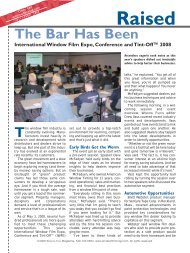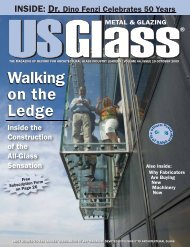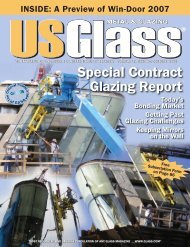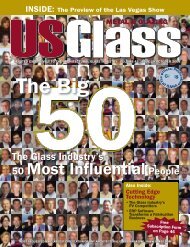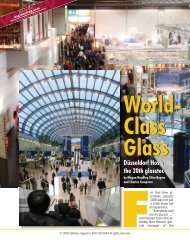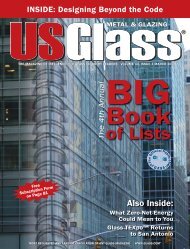US Glass - April 2008 - USGlass Magazine
US Glass - April 2008 - USGlass Magazine
US Glass - April 2008 - USGlass Magazine
You also want an ePaper? Increase the reach of your titles
YUMPU automatically turns print PDFs into web optimized ePapers that Google loves.
In his keynote, Olympian Mike Eruzione<br />
showed there really is a connection<br />
between the glass business and hockey.<br />
Jim Fairley of Colonial <strong>Glass</strong> suggested<br />
several systems that can make a<br />
business more efficient.<br />
Richard Kalson of Thorp Reed &<br />
Armstrong returned to BEC with an<br />
update on 2007 law developments.<br />
03 Guide for In-Situ Structural Silicone<br />
Glazing Evaluation; C1401-02 Guide for<br />
Structural Sealant Glazing; and C1487-<br />
02 Guide for Remedying Structural Silicone<br />
Glazing.<br />
Later, Bruce Werner of Curtain Wall<br />
Design and Consulting Inc. and Peter<br />
Poirier of Tremco Inc. formed a panel<br />
about four-sided structural silicone glazing.<br />
As Werner pointed out, the talk in<br />
Las Vegas was apropos as the City Center<br />
project on the Strip is the largest<br />
structural silicone glazed (SSG) construction<br />
project in the world. Since the<br />
first SSG building was constructed in<br />
1971, it has become “a mature technology,”<br />
Werner said.<br />
Ted Derby of Pohl Inc. of America<br />
touched on a newer technology: rainscreens.<br />
During “The Application of the<br />
Rainscreen Principle with Current Construction<br />
Practices,” Pohl made a case<br />
for the use of vented walls, or walls that<br />
allow air to move around but still manage<br />
water, thereby preventing problems such<br />
as mold. He said that with open joint systems<br />
designers can create a façade with<br />
enough vents that the pressure on the<br />
veneer equals the pressure on wall cavity,<br />
so water drains right down.<br />
One question that comes up is<br />
whether energy efficiency can be maintained<br />
with vented walls. According to<br />
Pohl, continuity in installation is the key<br />
to improved energy efficiency.<br />
He also noted that rainscreens can<br />
be incorporated into unitized curtainwall<br />
systems. “A lot of pre-engineering<br />
is done with these systems,” he says,<br />
adding that this can help maintain topnotch<br />
quality control.<br />
Richard Green, P.E., and Stanley Yee<br />
of The Façade Group also discussed new<br />
technology. The duo went through the<br />
design, development and implementation<br />
of a 300,000-square-foot point-supported<br />
glass wall at the new Bangkok<br />
International Airport. One of the ten<br />
largest airports in the world, its curtainwall<br />
system incorporates a number of<br />
new technologies, including point-fixed,<br />
heat-strengthened laminated glass and<br />
intricate stainless steel components.<br />
Green and Yee walked their listeners<br />
through the development of the tension<br />
truss support system and the stainless<br />
steel components—and the challenges<br />
they faced in testing the holes drilled into<br />
the glass for these components.<br />
Patrick Muessig of Azon <strong>US</strong>A focused<br />
on the topic of energy, specifically, energy<br />
modeling. Muessig introduced his<br />
audience to some of the tools available<br />
for this topic, from the National Fenestration<br />
Rating Council’s (NFRC) Component<br />
Modeling Approach (CMA) and<br />
AAMA 507, Standard Practice for Determining<br />
the Thermal Performance<br />
Characteristics of Fenestration Systems<br />
Installed in Commercial Buildings, as<br />
well as an overview of some of the federal<br />
legislation pointing toward requirements<br />
for energy-efficient buildings, including<br />
the recently passed Energy Independence<br />
and Security Act of 2007<br />
(see March <strong>2008</strong> <strong>US</strong><strong>Glass</strong>, page 46).<br />
He also suggested looking at COM-<br />
FEN—a software tool coming from the<br />
Lawrence Berkeley National Laboratory<br />
to be used for calculating heating and<br />
cooling energy use of fenestration products<br />
in commercial buildings—as the<br />
next generation of energy modeling. “I<br />
think it’s going to be a very nice product<br />
for our industry,” he said.<br />
Raj Goyal of Graham Architectural<br />
Products presented information about<br />
designing for blasts per the new UFC-<br />
DOD standard. “We all have dealt with<br />
disasters like water infiltration,” Goyal<br />
said, “but in these cases we are designing<br />
for life safety.”<br />
His videos of flying glass shards following<br />
test explosions impressed upon<br />
his audience the importance of following<br />
the 2007 document and thoroughly<br />
understanding its requirements.<br />
During his presentation “Protecting<br />
Exterior Fenestration & Glazing Surfaces<br />
with Applied Protective Coatings,”<br />
Mike Burk of Edgetech IG<br />
touched on the topic of window cleaning,<br />
which had been discussed earlier<br />
during <strong>Glass</strong> Week.<br />
He called today’s high-performance<br />
glass products and metal scrapers<br />
used by window cleaners “a disastrous<br />
combination.”<br />
© <strong>2008</strong> <strong>US</strong><strong>Glass</strong> magazine. 540-720-5584 All rights reserved.



